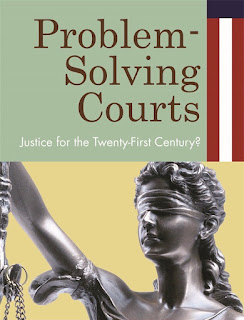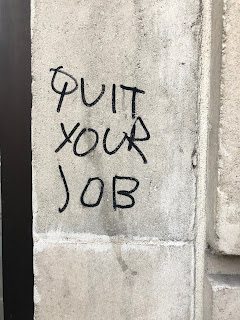Adapting to Change
The field of criminal justice has shifted in some dramatic ways over the past half decade or so. In the 1990s and 2000s, the field seemed to me dominated by a perception that "tough-on-crime" policymaking was the preferred mode of both political actors and the general public. Against this backdrop, those who were interested in advancing the idea of rehabilitation had to be both modest and cautious. In those years, even when Democrats were ascendant in the White House or local state houses, reformers took great pains to highlight the cost-effectiveness of alternatives to incarceration. Many adopted the language of "evidence-based programs" as a means to depoliticize the conversation about crime, making a technocratic case for less punitive policymaking.
Even though I have been alive and (mostly) awake through these years, I'm not 100 percent certain why the field of criminal justice has changed so much as our current decade has progressed. Certainly, Michele Alexander's book The New Jim Crow has had an enormous impact, as has Ta-Nehisi Coates' writings about mass incarceration. I think that the rise of social media, and the amplification it has given to ideas (for better and for worse) that were previously obscure or extreme, has also played a role. I'd also argue that the improvement in public safety in many American cities has been a significant underlying factor, reducing levels of fear among the chattering class in places like New York and Washington DC.
Whatever the reasons, there has been a rejiggering of the criminal justice narrative, at least in intellectual circles. Many politicians, advocates, and academics now view criminal justice primarily through a civil rights lens. This lens has sharpened our focus on racial disparities within the justice system and on the manifold harms that can accompany conviction and incarceration, not just for the individual defendant but for his family and community as well. It has pricked the moral conscience of many Americans and generated an outpouring of both compassion and outrage. All of a sudden, ideas that would have been non-starters less than a decade ago -- closing Rikers Island! raising the age of criminal responsibility! eliminating cash bail! decriminalizing marijuana! etc etc -- are not only plausible but popular across a fairly broad political spectrum. An array of new funders and new organizations have emerged to advance these and other ambitious goals.
How long this will last is anyone's guess. The tectonic plates of public opinion and government policymaking tend to shift slowly. For example, we continued to pursue high rates of incarceration well after the crime spikes of the 1970s and 1980s faded. So, if history is any guide, we may be in our current mode for quite some time -- I think only a sustained uptick in crime, and the resulting public and political backlash, would be capable of altering the trajectory of the moment.
All of this is mostly good news for those of us in the criminal justice reform business. To be sure, there is the danger of over-correction. We should be mindful of babies and bathwater. Our desire to transform the justice system should not be heedless -- we cannot blithely dispense with practices that have proven to be effective at curbing local crime or core principles (e.g. due process) that continue to make the American justice system a model for many countries around the world.
Our current criminal justice moment does offer some challenges for someone like me who lived through the bad old days when urban life really was defined by high levels of street crime and disorder. Starting my professional career in 1990, I was profoundly shaped by the era when isolated and incremental criminal justice reform was the best that could ever be achieved -- and even this took a huge measure of political skill along with a healthy dose of luck.
These years profoundly shaped my worldview. They taught me to focus on the importance of using empirical evidence, establishing realistic goals, and promoting neighborhood safety. They also impressed upon me the value of using plain language that is not ideologically freighted in order to speak to as wide an audience as possible.
In recent days, I have been attempting in my writing to bring these values forward while adapting to the exigencies (and passions) of our current moment. Here are a few examples:
Why We Need to Rethink Misdemeanor Justice (Governing)
Can We Stop Both Crime and Incarceration? (Public Books)
The Need To Balance Police Effectiveness and Fairness (Governing)
A Blueprint for 21st Century Policing (with David Weisburd) (The Hill)
Reducing the Justice Footprint (The Crime Report)
Even though I have been alive and (mostly) awake through these years, I'm not 100 percent certain why the field of criminal justice has changed so much as our current decade has progressed. Certainly, Michele Alexander's book The New Jim Crow has had an enormous impact, as has Ta-Nehisi Coates' writings about mass incarceration. I think that the rise of social media, and the amplification it has given to ideas (for better and for worse) that were previously obscure or extreme, has also played a role. I'd also argue that the improvement in public safety in many American cities has been a significant underlying factor, reducing levels of fear among the chattering class in places like New York and Washington DC.
Whatever the reasons, there has been a rejiggering of the criminal justice narrative, at least in intellectual circles. Many politicians, advocates, and academics now view criminal justice primarily through a civil rights lens. This lens has sharpened our focus on racial disparities within the justice system and on the manifold harms that can accompany conviction and incarceration, not just for the individual defendant but for his family and community as well. It has pricked the moral conscience of many Americans and generated an outpouring of both compassion and outrage. All of a sudden, ideas that would have been non-starters less than a decade ago -- closing Rikers Island! raising the age of criminal responsibility! eliminating cash bail! decriminalizing marijuana! etc etc -- are not only plausible but popular across a fairly broad political spectrum. An array of new funders and new organizations have emerged to advance these and other ambitious goals.
How long this will last is anyone's guess. The tectonic plates of public opinion and government policymaking tend to shift slowly. For example, we continued to pursue high rates of incarceration well after the crime spikes of the 1970s and 1980s faded. So, if history is any guide, we may be in our current mode for quite some time -- I think only a sustained uptick in crime, and the resulting public and political backlash, would be capable of altering the trajectory of the moment.
All of this is mostly good news for those of us in the criminal justice reform business. To be sure, there is the danger of over-correction. We should be mindful of babies and bathwater. Our desire to transform the justice system should not be heedless -- we cannot blithely dispense with practices that have proven to be effective at curbing local crime or core principles (e.g. due process) that continue to make the American justice system a model for many countries around the world.
Our current criminal justice moment does offer some challenges for someone like me who lived through the bad old days when urban life really was defined by high levels of street crime and disorder. Starting my professional career in 1990, I was profoundly shaped by the era when isolated and incremental criminal justice reform was the best that could ever be achieved -- and even this took a huge measure of political skill along with a healthy dose of luck.
These years profoundly shaped my worldview. They taught me to focus on the importance of using empirical evidence, establishing realistic goals, and promoting neighborhood safety. They also impressed upon me the value of using plain language that is not ideologically freighted in order to speak to as wide an audience as possible.
In recent days, I have been attempting in my writing to bring these values forward while adapting to the exigencies (and passions) of our current moment. Here are a few examples:
Why We Need to Rethink Misdemeanor Justice (Governing)
Can We Stop Both Crime and Incarceration? (Public Books)
The Need To Balance Police Effectiveness and Fairness (Governing)
A Blueprint for 21st Century Policing (with David Weisburd) (The Hill)
Reducing the Justice Footprint (The Crime Report)


